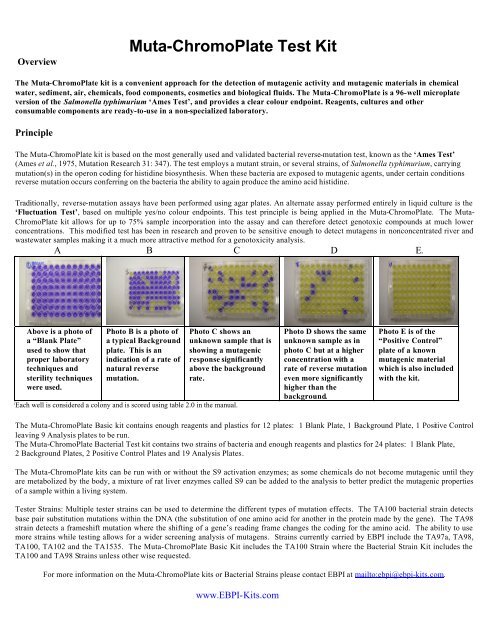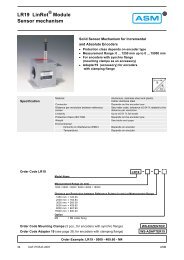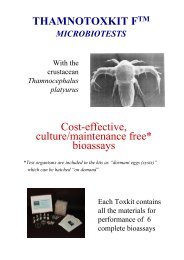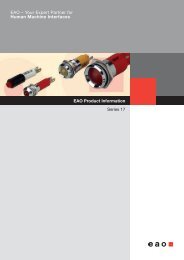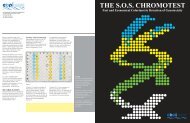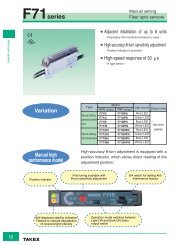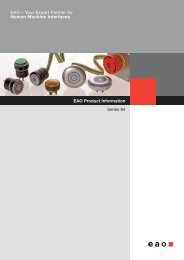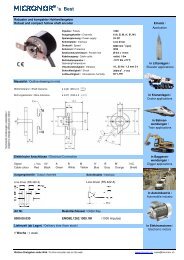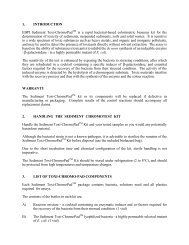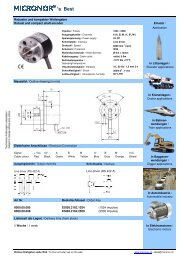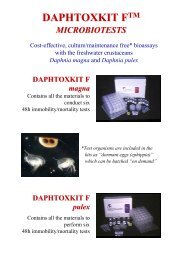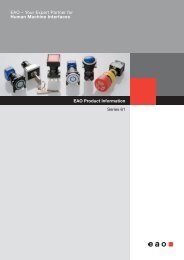MUTA-CHROMOPLATE TEST KIT - General Teknik Elektronik
MUTA-CHROMOPLATE TEST KIT - General Teknik Elektronik
MUTA-CHROMOPLATE TEST KIT - General Teknik Elektronik
You also want an ePaper? Increase the reach of your titles
YUMPU automatically turns print PDFs into web optimized ePapers that Google loves.
Overview<br />
Muta-ChromoPlate Test Kit<br />
The Muta-ChromoPlate kit is a convenient approach for the detection of mutagenic activity and mutagenic materials in chemical<br />
water, sediment, air, chemicals, food components, cosmetics and biological fluids. The Muta-ChromoPlate is a 96-well microplate<br />
version of the Salmonella typhimurium ‘Ames Test’, and provides a clear colour endpoint. Reagents, cultures and other<br />
consumable components are ready-to-use in a non-specialized laboratory.<br />
Principle<br />
The Muta-ChromoPlate kit is based on the most generally used and validated bacterial reverse-mutation test, known as the ‘Ames Test’<br />
(Ames et al., 1975, Mutation Research 31: 347). The test employs a mutant strain, or several strains, of Salmonella typhimurium, carrying<br />
mutation(s) in the operon coding for histidine biosynthesis. When these bacteria are exposed to mutagenic agents, under certain conditions<br />
reverse mutation occurs conferring on the bacteria the ability to again produce the amino acid histidine.<br />
Traditionally, reverse-mutation assays have been performed using agar plates. An alternate assay performed entirely in liquid culture is the<br />
‘Fluctuation Test’, based on multiple yes/no colour endpoints. This test principle is being applied in the Muta-ChromoPlate. The Muta-<br />
ChromoPlate kit allows for up to 75% sample incorporation into the assay and can therefore detect genotoxic compounds at much lower<br />
concentrations. This modified test has been in research and proven to be sensitive enough to detect mutagens in nonconcentrated river and<br />
wastewater samples making it a much more attractive method for a genotoxicity analysis.<br />
A B C D E.<br />
Above is a photo of<br />
a “Blank Plate”<br />
used to show that<br />
proper laboratory<br />
techniques and<br />
sterility techniques<br />
were used.<br />
Photo B is a photo of<br />
a typical Background<br />
plate. This is an<br />
indication of a rate of<br />
natural reverse<br />
mutation.<br />
Photo C shows an<br />
unknown sample that is<br />
showing a mutagenic<br />
response significantly<br />
above the background<br />
rate.<br />
*Each well is considered a colony and is scored using table 2.0 in the manual.<br />
Photo D shows the same<br />
unknown sample as in<br />
photo C but at a higher<br />
concentration with a<br />
rate of reverse mutation<br />
even more significantly<br />
higher than the<br />
background.<br />
Photo E is of the<br />
“Positive Control”<br />
plate of a known<br />
mutagenic material<br />
which is also included<br />
with the kit.<br />
The Muta-ChromoPlate Basic kit contains enough reagents and plastics for 12 plates: 1 Blank Plate, 1 Background Plate, 1 Positive Control<br />
leaving 9 Analysis plates to be run.<br />
The Muta-ChromoPlate Bacterial Test kit contains two strains of bacteria and enough reagents and plastics for 24 plates: 1 Blank Plate,<br />
2 Background Plates, 2 Positive Control Plates and 19 Analysis Plates.<br />
The Muta-ChromoPlate kits can be run with or without the S9 activation enzymes; as some chemicals do not become mutagenic until they<br />
are metabolized by the body, a mixture of rat liver enzymes called S9 can be added to the analysis to better predict the mutagenic properties<br />
of a sample within a living system.<br />
Tester Strains: Multiple tester strains can be used to determine the different types of mutation effects. The TA100 bacterial strain detects<br />
base pair substitution mutations within the DNA (the substitution of one amino acid for another in the protein made by the gene). The TA98<br />
strain detects a frameshift mutation where the shifting of a gene’s reading frame changes the coding for the amino acid. The ability to use<br />
more strains while testing allows for a wider screening analysis of mutagens. Strains currently carried by EBPI include the TA97a, TA98,<br />
TA100, TA102 and the TA1535. The Muta-ChromoPlate Basic Kit includes the TA100 Strain where the Bacterial Strain Kit includes the<br />
TA100 and TA98 Strains unless other wise requested.<br />
For more information on the Muta-ChromoPlate kits or Bacterial Strains please contact EBPI at mailto:ebpi@ebpi-kits.com.<br />
www.EBPI-Kits.com


